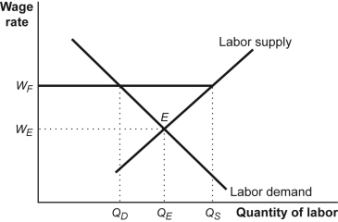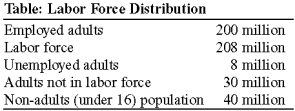A) would increase if a larger percentage of the labor force were over 25 years old.
B) would increase if union membership fell.
C) would increase if unemployment benefits were increased.
D) will always remain fixed.
F) A) and B)
Correct Answer

verified
Correct Answer
verified
True/False
If the U.S. dollar were replaced with a "new dollar" at an exchange rate of 1 new dollar for 4 old dollars, then an hourly wage of $12 would become an hourly wage of 3 new dollars.
B) False
Correct Answer

verified
Correct Answer
verified
Multiple Choice
Which annual rate of inflation is hyperinflation?
A) 5%
B) 13%
C) 25%
D) 2,000%
F) A) and D)
Correct Answer

verified
Correct Answer
verified
True/False
The use of online banking increases the unit-of-account cost of a high inflation rate.
B) False
Correct Answer

verified
Correct Answer
verified
Multiple Choice
If Jim's income is $80,000 and the price level is 4, then Jim's real income is:
A) $20,000.
B) $320,000.
C) $84,000.
D) $80,000.
F) C) and D)
Correct Answer

verified
Correct Answer
verified
Multiple Choice
A bank makes a loan for one year. The nominal annual interest rate is 7.5%. The real rate is 4%. Over the course of the year, overall prices increase by 4%. This rate of inflation hurt the _____ because the actual rate of inflation was _____ than the anticipated rate.
A) borrower; lower
B) borrower; higher
C) lender; higher
D) lender; lower
F) A) and B)
Correct Answer

verified
Correct Answer
verified
Multiple Choice
If actual unemployment is 6.2% and the natural rate is 4%, cyclical unemployment is:
A) 6.2%.
B) 10.2%.
C) 4%.
D) 2.2%.
F) A) and D)
Correct Answer

verified
Correct Answer
verified
True/False
A jobless recovery occurs when GDP is decreasing and unemployment is rising.
B) False
Correct Answer

verified
Correct Answer
verified
Multiple Choice
Menu costs are the:
A) costs of money becoming less reliable.
B) real costs of changing listed prices.
C) increase in the transaction costs caused by inflation.
D) adjustments to the cost of living.
F) A) and C)
Correct Answer

verified
Correct Answer
verified
Multiple Choice
A survey reveals that on a small island initially 1,000 people have jobs, 250 people are not working but are looking for jobs, and 450 people are neither working nor looking for work. Suppose that 150 of the 450 people who weren't looking for work now begin looking for work. There are now 400 people looking for work and 1,000 people working. The unemployment rate:
A) falls to 20%.
B) rises to 28.6%.
C) rises to 50%.
D) Nothing happens to the unemployment rate, because these people weren't working before and they aren't working now.
F) A) and C)
Correct Answer

verified
Correct Answer
verified
Multiple Choice
When the demand for labor is falling and employers have committed to high wages, _____ unemployment will result.
A) frictional
B) cyclical
C) permanent
D) structural
F) A) and C)
Correct Answer

verified
Correct Answer
verified
Multiple Choice
If the wage rate is $9 per hour and the price level is 2, then the real wage is:
A) $18.
B) $11.
C) $7.
D) $4.50.
F) A) and C)
Correct Answer

verified
Correct Answer
verified
Multiple Choice
The Republic of Livonia has an adult population of 100 million; 60% of Livonia's population is employed, and 10% of the people are unemployed. The labor force participation rate in Livonia is:
A) 70%.
B) 60%.
C) 7%.
D) 10%.
F) B) and C)
Correct Answer

verified
Correct Answer
verified
Multiple Choice
Which of the following statements is FALSE?
A) Both frictional and structural unemployment can occur even if unemployment is at its natural level.
B) Cyclical unemployment is unemployment in excess of the natural rate.
C) A new college graduate looking for that first professional job may be frictionally unemployed.
D) Efficiency wages may cause frictional unemployment.
F) None of the above
Correct Answer

verified
Correct Answer
verified
Multiple Choice
The rate of unemployment when the economy is at full employment is:
A) zero.
B) the natural rate.
C) the structural rate.
D) less than the full employment rate of unemployment.
F) All of the above
Correct Answer

verified
Correct Answer
verified
Multiple Choice
Since the 1960s, the U.S. price level has _____ and the inflation rate has _____.
A) remained constant; increased
B) increased; fluctuated
C) decreased; decreased
D) fluctuated; remained constant
F) All of the above
Correct Answer

verified
Correct Answer
verified
Multiple Choice
Use the following to answer questions  -(Table: The Consumer Price Index (CPI) ) Look at the table The Consumer Price Index (CPI) . The inflation rate between 2011 and 2012 was:
-(Table: The Consumer Price Index (CPI) ) Look at the table The Consumer Price Index (CPI) . The inflation rate between 2011 and 2012 was:
A) 10%.
B) 3%.
C) 1.4%.
D) 24.6%.
F) C) and D)
Correct Answer

verified
Correct Answer
verified
Multiple Choice
Use the following to answer questions
Figure: The Effect of a Minimum Wage  -(Figure: The Effect of a Minimum Wage) Look at the figure The Effect of a Minimum Wage. Suppose the labor market is in equilibrium at E when the government imposes a minimum wage of WF. Structural unemployment will equal:
-(Figure: The Effect of a Minimum Wage) Look at the figure The Effect of a Minimum Wage. Suppose the labor market is in equilibrium at E when the government imposes a minimum wage of WF. Structural unemployment will equal:
A) QS - QD.
B) QE - QD.
C) QS - QE.
D) zero.
F) A) and D)
Correct Answer

verified
Correct Answer
verified
Multiple Choice
Employment is the total:
A) labor force.
B) population of working age.
C) number of people actively working, either full-time or part-time.
D) number of people not unemployed.
F) A) and D)
Correct Answer

verified
Correct Answer
verified
Multiple Choice
Use the following to answer questions  -(Table: Labor Force Distribution) Look at the table Labor Force Distribution. The unemployment rate is:
-(Table: Labor Force Distribution) Look at the table Labor Force Distribution. The unemployment rate is:
A) 3.85%.
B) 10%.
C) 4.55%.
D) 6.75%.
F) B) and D)
Correct Answer

verified
Correct Answer
verified
Showing 281 - 300 of 351
Related Exams